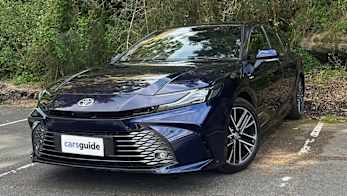It's a tough job splitting these high-end battery-powered super green machines.
At first glance it seems a classic David and Goliath battle: Silicon Valley start-up versus German automotive powerhouse. One company will sell roughly 40,000 cars this year, the other more than 2 million.
But nothing can be taken for granted in the brave new world of battery-powered sports cars. Tesla's Model S may sell only in small numbers but it is hailed as a breakthrough car, while BMW's i8 hybrid has met with a lukewarm response.
In the international engine of the year awards, Tesla won the gong for best green engine, the i8 hybrid was runner-up. The Tesla's two electric motors put out a combined 515kW of power and 967Nm of torque, dwarfing the BMW's 266kw and 570Nm. So who's David and who's Goliath?
You can feel the power difference when you hit the accelerators. The Tesla snaps your head back and pins your ears to the headrest, while the BMW has you leaning forward urging it on like a jockey going for the whip.
Electric cars are now the bulging-muscled bully boys
If it's any consolation to BMW fans, the i8 sounds more like a sports car with its fake exhaust note piped into the cabin. The Tesla is almost silent, save for the expletives of delight from the driver and the faint electric whirr of a motor, which sounds like a distant aircraft hitting reverse thrust.
Tesla says the Model S is good for a 0-100km/h sprint in 3.3 seconds and BMW claims 4.4 secs for the i8. By the seat of the pants they are streets apart.
After years spent as the bespectacled weaklings in the automotive playground, electric cars are now the bulging-muscled bully boys. As if to ram home the performance, the Tesla has an "insane" mode, activated by a swipe of the centre screen menu, which makes it a couple of tenths quicker. Pay for an upgrade and you get "ludicrous" mode, which shaves another 0.3 secs off the 0-100km/h sprint.
But EV's weakness has always been range anxiety. Zero-emission cars may be able to outpace hybrids but they can't outrun them.
The Model S P85D goes a long way to putting those fears to bed with a claimed range of 491km. An optional upgrade pumps that up to 528km, which is getting close to the claimed combined range of the i8 at 600km. It's also more than you'll get between fills with some V8s.
Drive it as if you stole it — or borrowed it — and you won't get anywhere near that.
Our brief drive, which admittedly included several 0-100km/h full-power bursts, with the acceleration setting on "Insane", saw the range settle at about 240km. You can partly blame winter for that result too, as the heater saps the battery.
The i8 on the other hand looked more likely to get within cooee of its claim, despite some enthusiastic driving.
In this battle, the BMW scores more points for looking the part. Side-by-side, it makes the Model S look anonymous.
Passers-by hardly notice the Tesla, drawn as they are by the futuristic flanks of the i8. It looks every bit the supercar with its scissor doors, bonnet scoop and space-age surfaces. Inside, it also shades the Tesla with its body hugging sports seats and bright blue ambient lighting.
The Tesla's massive centre screen looks like an oversized iPad and works like one too, with pinch and swipe features and excellent clarity. Its cabin feels luxurious enough but the borrowed Mercedes-Benz switchgear and plain detailing in the cabin detract from the overall effect.
Its supercar-like performance isn't matched by the cabin character or flair of a Lamborghini, Ferrari or even Maserati. It's more touring car than sports car but that has its pluses — for example, enough room for adults to stretch out in comfort, front and rear.
The Tesla is no match for the BMW through the bends. With a low centre of gravity thanks to the bank of batteries that make up its floor, the Tesla grips impressively through corners and steers faithfully.
However, you can feel those two-plus tonnes — it doesn't lean but it does resist taking tight hairpins at speed. The BMW on the other hand feels lithe and nimble through the bends, with sharp steering and great grip and drive.
Each has impressive safety credentials. Tesla recently matched the i8 by adding auto emergency braking, blind spot warning and side collision warning.
A software upgrade is available on the latest model, allowing customers to upgrade driver aids. They include a new Autopilot feature to keep the car in its lane or, simply by hitting the indicator, execute lane changes.
As for pricing, the Tesla comes in at almost $100,000 cheaper, courtesy of US Government backing. That discrepancy also puts to bed another electric car concern.
Small electric hatchbacks are exorbitantly priced against their petrol rivals but, in this rarefied air, the Tesla comes across as a bargain.
Verdict
The Tesla and i8 are fascinating, approaching environmentally responsible performance in very different ways. Both have their merits — and the mind boggles at what they could achieve in partnership.
The Model S wins because it delivers more for less: more grunt, fewer emissions and the prospect of improvement in the future through software upgrades.
BMW i8
-wide.jpg)
Price from: About $323,000 drive-away
Warranty: 3 years/unlimited km
Capped servicing: 3 year/$60,000km, from $1627 to $2936
Service interval: Condition-based
Safety: 5 stars, 8 airbags
Engine: 1.5-litre 3-cyl turbo, electric motor, 266kW/570Nm combined
Transmission: 6-speed (engine), 2-speed (motor)
Thirst: 2.1L/100km (claimed)
Dimensions: 4689mm (L), 1942mm (W), 1291mm (H), 2800mm (WB)
Weight: 1485kg
Range: Up to 600km
Spare: None; repair kit
0-100km/h: 4.4 secs (claimed)
Tesla Model S
-wide.jpg)
Price from: About $237,000 drive-away
Warranty: 4 years/80,000km (8 years/unlimited km on battery and motor)
Capped servicing: N/A
Service interval: 12 months recommended
Safety: 5 stars, 6 airbags
Engine: Electric motor, 515kW/967Nm
Transmission: Single-ratio
Thirst: 238 Watt-hours/km
Dimensions: 4970mm (L), 1964mm (W), 1435mm (H), 2960mm (WB)
Weight: 2100kg-2200kg
Range: 491km
Spare: None; repair kit
0-100km/h: 3.3secs (claimed)






.jpg)
.jpg)
.jpg)
.jpg)

.jpg)
.jpg)
.jpg)
.jpg)
.jpg)
.jpg)
.jpg)
.jpg)
.jpg)
.jpg)
.jpg)
.jpg)
.jpg)
.jpg)
.jpg)
.jpg)
.jpg)
.jpg)
.jpg)
.jpg)
.jpg)
.jpg)
.jpg)
.jpg)
.jpg)
.jpg)
.jpg)
.jpg)
.jpg)
.jpg)
.jpg)
.jpg)
.jpg)
.jpg)
.jpg)
.jpg)
.jpg)
.jpg)
.jpg)
.jpg)


.jpg)

.jpg)
-w.jpg)



